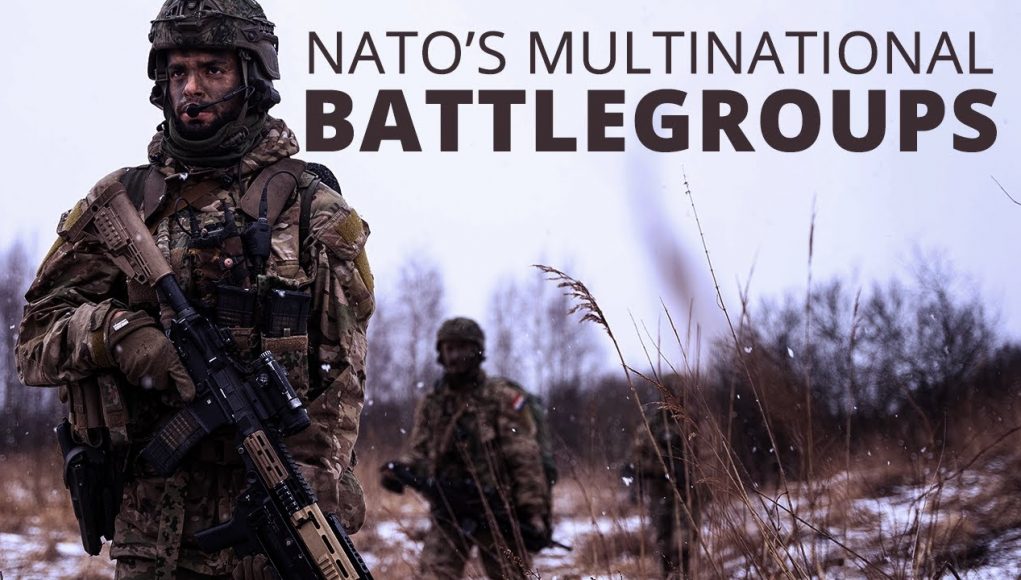It’s been five years since NATO deployed four multinational battlegroups to its eastern flank. The battlegroups, stationed in the three Baltic States – Estonia, Latvia and Lithuania – as well as in Poland, were one of several measures announced in response to Russia’s illegal and illegitimate annexation of the Crimean peninsula in Ukraine in 2014. As they commemorate their fifth anniversary, the battlegroups, led by Canada, Germany, the United Kingdom and the United States, remain combat-ready, demonstrate the strength of the transatlantic bond between Europe and North America, and make clear that an attack on one Ally would be considered an attack on all.
After Russia’s unprovoked and brutal invasion of Ukraine, which began on 24 February 2022, NATO announced the formation of four more battlegroups in Bulgaria, Hungary, Romania and Slovakia. This video examines the role of the battlegroups, how they train and operate, and what they bring to the Alliance. Featuring interviews from battlegroup commanders, it also looks back at the deployment of the battlegroups and the cause of their placement in the east of the Alliance.
#NATO, #summit, #EasternFlank, #Madrid, #BattleGroups
NATO’s military presence in the eastern part of the Alliance is a key part of NATO’s strengthened deterrence and defence posture, which has been enhanced in recent years to reflect the new security reality in the Euro-Atlantic area. Russia’s illegal annexation of Crimea, continued aggression against its neighbours and full-fledged invasion of Ukraine have fundamentally changed the security environment in Europe, and NATO has responded by significantly strengthening its readiness to protect and defend all Allies. The forward presence of Allied forces is defensive, proportionate, transparent and in line with the Alliance’s international commitments and obligations. It represents a significant commitment by Allies and is a tangible reminder that an attack on one NATO member country is an attack on all.
NATO’s forward presence comprises eight multinational battalion-size battlegroups, provided by framework nations and other contributing Allies on a voluntary, fully sustainable and rotational basis. The battlegroups operate in concert with national home defence forces and are present at all times in the host countries.
The battlegroups are not identical; their make-up is tailored to geographic and host nation requirements. Overall, military effectiveness guides each battlegroup’s composition. Today, troops from over 20 Allies serve, train and exercise together, representing a strong expression of Alliance unity and solidarity.
The eight battlegroups are composed of the following Allies:
Host nation: Bulgaria
Framework nation: Bulgaria
Contributing nations: United States
Host nation: Estonia
Framework nation: United Kingdom
Contributing nations: Denmark and France
Host nation: Hungary
Framework nation: Hungary
Contributing nations: Croatia and the United States
Host nation: Latvia
Framework nation: Canada
Contributing nations: Albania, the Czech Republic, Italy, Montenegro, Poland, Slovakia, Slovenia and Spain
Host nation: Lithuania
Framework nation: Germany
Contributing nations: Belgium, the Czech Republic, Iceland, Luxembourg, the Netherlands and Norway
Host nation: Poland
Framework nation: United States
Contributing nations: Croatia, Romania and the United Kingdom
Host nation: Romania
Framework nation: France
Contributing nations: Belgium, Poland, Portugal and the United States
Host nation: Slovakia
Framework nation: the Czech Republic
Contributing nations: Germany and the Netherlands
The four north-eastern battlegroups (in Estonia, Latvia, Lithuania and Poland) are under NATO command through the Multinational Corps Northeast Headquarters in Szczecin, Poland. Two division-level headquarters coordinate training and preparation activities of their respective battlegroups. Multinational Division Northeast Headquarters located in Elblag, Poland has been fully operational since December 2018. This headquarters works closely with the battlegroups in Poland and Lithuania. A complementary Multinational Division North Headquarters was activated by NATO in October 2020 and is moving towards full operational capability. Its forward elements are located in Adazi, Latvia, while the rest of the headquarters is located in Karup, Denmark. This headquarters cooperates closely with the battlegroups in Estonia and Latvia.
The four new battlegroups (in Bulgaria, Hungary, Romania and Slovakia) are currently being set up and integrated into NATO’s command structure. They will ultimately exist under the responsibility of Allied Joint Force Command Brunssum (for the battlegroups in Hungary and Slovakia) and Allied Joint Force Command Naples (for the battlegroups in Bulgaria and Romania).
In addition, many activities undertaken by Allies nationally – while not formally part of NATO’s forward presence – also contribute to increased Allied activity in the eastern part of the Alliance.
NATO’s rapid reinforcement strategy also ensures that forward presence forces will be reinforced by NATO’s Very High Readiness Joint Task Force (VJTF), the broader NATO Response Force, Allies’ additional high readiness forces and NATO’s heavier follow-on forces, if necessary.




